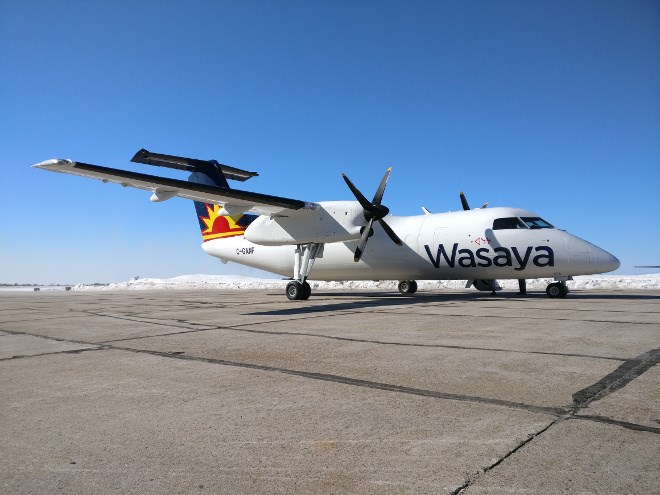When Michael Rodyniuk went looking for capital to take Wasaya Airways to the next level, he went back to his old employer.
The president-CEO of the First Nation-owned airline announced Feb. 1 that it had struck a $25-million debt and equity deal with Exchange Income Corporation (EIC) to recapitalize the once-troubled regional carrier and elevate it to new heights.
“This gives us the capital to grow the company and take it to the point where we’ve never seen Wasaya go before,” said Rodyniuk.
Wasaya, which is owned by 12 First Nation communities and serves 25 destinations in northwestern Ontario, launched flights into Winnipeg last year. About 35 per cent of its 320-employee workforce is Indigenous.
With close to 30 years of experience in aviation management, marketing and sales, Rodyniuk had been vice-president and COO of the aviation arm of Exchange Income Corporation, the Winnipeg parent company that purchased Bearskin Airlines in 2010.
EIC’s holdings include ownership of Perimeter Aviation (which includes Bearskin), Keewatin Air, Calm Air International, Custom Helicopters, Regional One and Provincial Aerospace.
When Rodyniuk joined Wasaya in May 2015 his three-step rebuilding program involved improving the day-to-day operational basics, such as their on-time performance, tackle a $35-million decades-old debt, and securing an equity partner to recapitalize the company.
Rodyniuk said they weren’t looking for financiers who wanted a three to five-year return on their investment. They needed someone who saw value in the potential of Wasaya and would be in it for the long haul.
“The great thing about having knowledge-based partners like Exchange is these guys know aviation like we do. Collectively, we can make some wise decisions on where we can put our assets to get the highest and best return.”
The transaction is expected to close on Feb. 28. What percentage of an ownership stake EIC is taking in Wasaya is being kept confidential for now under the terms of the agreement.
“They see the positive work that our team has been doing,” said Rodyniuk, who praised the effort of his management and rank-and-file.
“They (EIC) see a well-positioned organization with good people that, if given access to low-cost capital, can grow dramatically. That’s our marching orders. Now that we’ve secured capital, we can move forward and grow.”
The money is earmarked to make some infrastructure improvements – repair a few leaky roofs and upgrade some building lighting – but it clears the way to add new aircraft to its 16-plane fleet.
An EIC subsidiary, Miami-based Regional One, maintains a stable of available regional aircraft and is a distributor of aircraft parts.
“We have a strategy that will see us move tactically in those areas where we see great opportunities,” said Rodyniuk.
Over the next two years, that means expanding into new markets with their Dash-8 aircraft, including east of Thunder Bay, into Western Canada, and south to U.S. cities.
Rodyniuk declined to get into specifics but said they’ve done market research in northeastern Ontario and the company sees niche opportunities with underserviced communities on the Quebec side of James Bay and Hudson Bay.
“There are just so many really good places that we can put our assets and get a really good return. Now that we’ve got the capital behind us, we’ll be able to work swiftly toward those.”
Closer to home, Wasaya intends to capture more of the regional air freight market to better serve the communities they fly into.
The company has retired their large twin-engine Hawker Siddeley cargo planes, some of which are older than Rodyniuk.
New deliveries are expected this spring. Rodyniuk said they’ve built a great relationship with Chorus Aviation through their Voyageur Aviaton subsidiary in North Bay on a fleet renewal plan.
Last year, Voyageur designed and converted a Dash-8 passenger aircraft into a dedicated package freighter, considered a “world first.”
Wasaya has two of the Dash-8-100PFs in service and would like to add more to deliver 10,000-pound payloads on the short, gravel runways in the remote communities they serve.
But Dash 8-100 aircraft are harder to source since they’re no longer in production.
The backing of EIC further allows them to consider more expensive aircraft that were previously unavailable to Wasaya, such as the ATR-42 twin turbo-prop aircraft.
“For us to have the luxury to contemplate new equipment was completely foreign to us up until we struck this deal with Exchange. You may see us take another look at our fleet.”
In a statement, Rodyniuk’s former boss, Mike Pyle, EIC’s chief executive officer, said the investment in Wasaya adheres to a core principle “to invest in and partner with our First Nation stakeholders. This partnership with Wasaya allows us to further enhance and extend our First Nation relations.”
Although EIC is a minority shareholder in Wasaya, Rodyniuk said they still remain competitors in northwestern Ontario.
Federal competition laws do not allow them to collude on fares, schedules or markets.
For the most part, Rodyniuk said, there’s no overlap with their respective networks but there are synergies to be had in sharing passengers and freight.
“They had a stated objective to move into northwestern Ontario and instead of spending all the capital to go toe-to-toe with us, they chose to partner with us. It gives them access to market without having to build it.”




